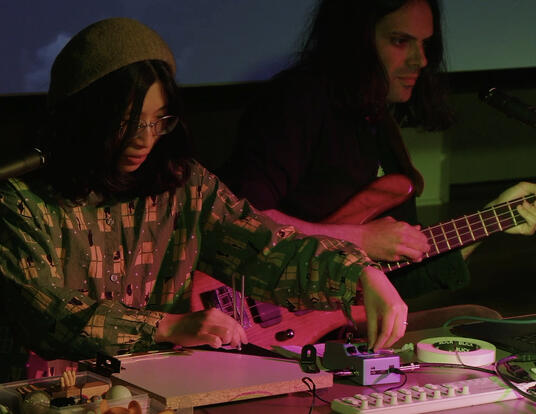When Stars Collide
Betty Hu, PhD student

Research at Risk: Since World War II, universities have worked with the federal government to create an innovation ecosystem that has yielded life-changing progress. Now much of that work may be halted as funding is withdrawn. Find out more about the threats to medical, engineering, and scientific research, as well as how Harvard is fighting to preserve this work—and the University's core values.
Betty Hu is a student in the Department of Physics at Harvard where she studies black holes and related astrophysical phenomena. She discusses her research, how she came to love astrophysics, and spending time at Café Gato Rojo in the Student Center at Harvard Griffin GSAS.
Tremendous Energy
Black holes come in a lot of different sizes. I focus on the largest variety: supermassive black holes. They exist at the center of most galaxies. (Our galaxy, the Milky Way, has one.) Researchers are always trying to get quality photographs of them.
Supermassive black holes have an extremely high mass, which means they also have a powerful gravitational force around them. This force affects the objects around the black hole, usually stars, in two ways: it pulls stars towards the black hole, creating a densely populated pocket of the universe that’s full of stars, and it causes the stars to move extremely fast, way faster than other parts of the universe. We don’t see this with our solar system because we aren’t very close to a black hole, but stars that neighbor a black hole might move at a speed that is a fraction of the speed of light.

Because these stars move so fast in such a densely populated area, they may collide with each other at speeds that you wouldn’t find in parts of the universe farther from a black hole. If they were to collide, we could possibly identify, observe, and quantify the tremendous energy released.
So my work started with a question: Could these star collisions happen? Using physics, we found they could—and at a rate that gave us hope to observe them as our technology improves. We want to set the parameters for potential identification and observation of future star collisions so we can learn more about the universe. It’s an exciting position to be in.
It’s an incredible time to study astronomy because our observational powers are improving. Every new generation of telescopes is much more powerful than the last. That means that I can get observational confirmation for my theoretical work. This interplay between theory and observed data is one of the things that makes astrophysics so interesting to me. Other areas of physics fall squarely in either theory or experimentation. In astrophysics, they’re bound together; you can’t effectively do one without the other.
A Closely Related Family
I took a general relativity course as an undergraduate at Columbia College and loved it. A lot of general relativity is a buildup to proving the existence of black holes, which can be theorized as a mathematical solution to an equation in general relativity. I started doing research with the professor who taught the class and was a former student of my current advisor here at Harvard. My academic family is very closely related.
One fond memory of Harvard Griffin GSAS is of Café Gato Rojo in the Student Center. It was closed for some time because of the pandemic but now it’s back open. I have some great memories of taking midday breaks with friends, paying a low price for good coffee, and going on long walking loops around the Yard, the Law School, the Radcliffe Quad, and then back to the astrophysics building.
I never lived in the residence halls myself, but weirdly enough I always felt connected to my classmates and cohort. I made friends with people I only knew through their fellow residents, for example. Even if some of us live on campus and some of us in apartments, we all feel like we’re roommates because of Harvard Griffin GSAS. The School has done a phenomenal job of fostering a sense of community despite the boundaries of cohort year or academic field, and I’m very appreciative of that.
This research was funded by the National Defense Science and Engineering Graduate Fellowship, the John Templeton Foundation, and the Gordon and Betty Moore Foundation.
Get the Latest Updates
Join Our Newsletter
Subscribe to Colloquy Podcast
Simplecast





